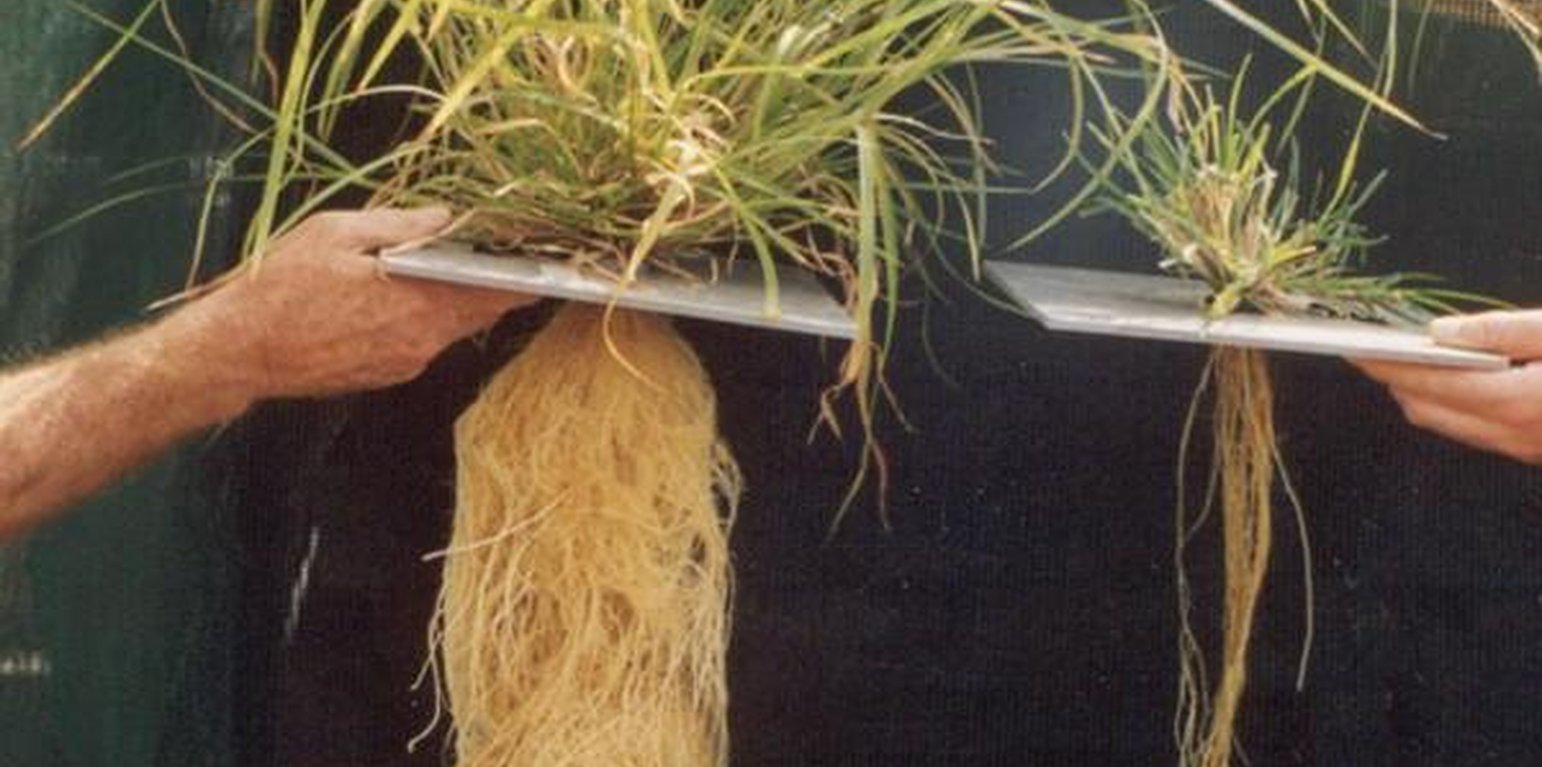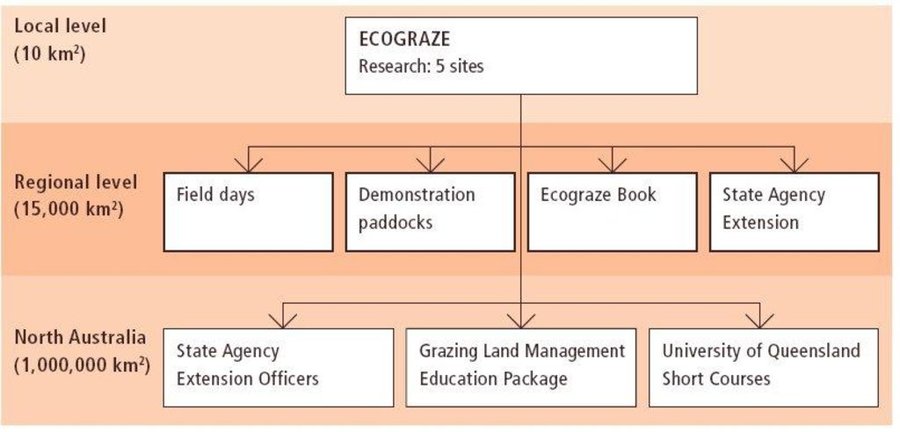Development and promotion of Ecograze
(ออสเตรเลีย)
คำอธิบาย
Research-based development and promotion of Ecograze principles and practices through on-farm testing and demonstration.
Aims / objectives: In 1992, Meat and Livestock Australia (MLA), a producer-owned company that provides services to the entire Australian red meat industry, initiated the Ecograze project. Ecograze was intended to provide innovative management options for the pastures in the eucalyptus woodlands of north-east Queensland. It was an eight-year collaborative research project undertaken by staff of the CSIRO (Commonwealth Scientific and Industrial Research Organisation) Sustainable Ecosystems and Queensland Department of Primary Industries with input from Queensland Department of Natural Resources and Mines. It formally concluded in 2001. However, many of the analyses and extension activities have been ongoing since then.
Methods: Ecograze was conducted on five commercial grazing properties that spanned different conditions and consequently allowed extrapolation of results to a much wider area across northern Australia. Practical grazing management strategies have been developed. The Ecograze team assessed the economic implications of managing land in various states by linking a pasture production model, to a model of farm economics. Research teams are currently testing the grazing management technology in commercial situations to understand the real costs and implications of implementing the research-derived Ecograze recommendations. The on-farm tests are supported by a number of new initiatives. These include a MLA funded project to specifically implement the Ecograze principles on farms as a means of reducing sediment and nutrients pollution of waterbodies. The National Action Plan for Salinity and Water Quality, through incentives, supports land management practices to reduce erosion, increase ground cover and minimise runoff. Funding is also provided by the Natural Heritage Trust to fence and sub-divide paddocks. All of these initiatives are supported by State Government agencies, who have extension staff based in the regions to assist farmers with implementing new practices. In the case of Ecograze, there are extension officers in the NE Queensland region who are actively promoting its management principles and are assisting producers in planning new strategies. Many of the Ecograze principles are also included in a new Grazing Land Management (GLM) Education package, developed by MLA and research and development agencies. The GLM package, which is delivered via a three-day workshop, is being extended to producers across northern Australia.
This approach highlights the importance of active collaboration between researchers, farmers, the beef industry and the government - in this case to develop a system to improve the condition of grazing lands. Through the central involvement of research, management options have been identified to suit different land users' needs, climates, grazing pressures and pasture conditions
สถานที่
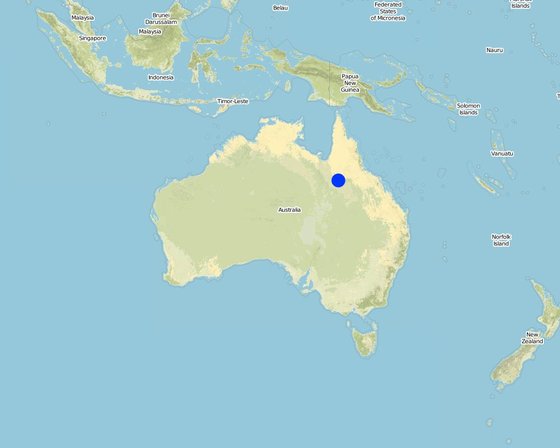
สถานที่: Queensland, Northern Australia, ออสเตรเลีย
ตำแหน่งทางภูมิศาสตร์ของสถานที่ที่ถูกเลือ
วันที่ริเริ่ม: 1992
ปีที่สิ้นสุด: 2001
ประเภทของแนวทาง
-
แบบดั้งเดิม/ แบบพื้นเมิอง
-
เป็นนวัตกรรมท้องถิ่นล่าสุด/ นวัตกรรมใหม่
-
ใช้โครงงานหรือแผนงานเป็นฐาน
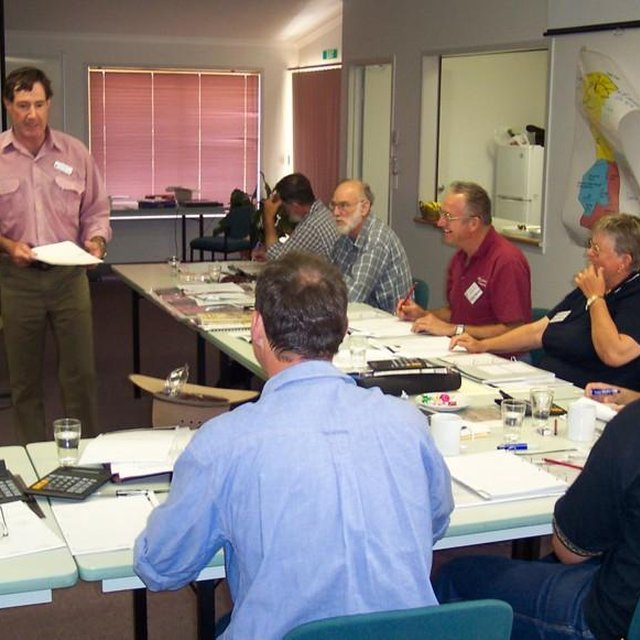
Programme organization: Ecograze principles are part of the Grazing Land Management education package delivered through workshops.
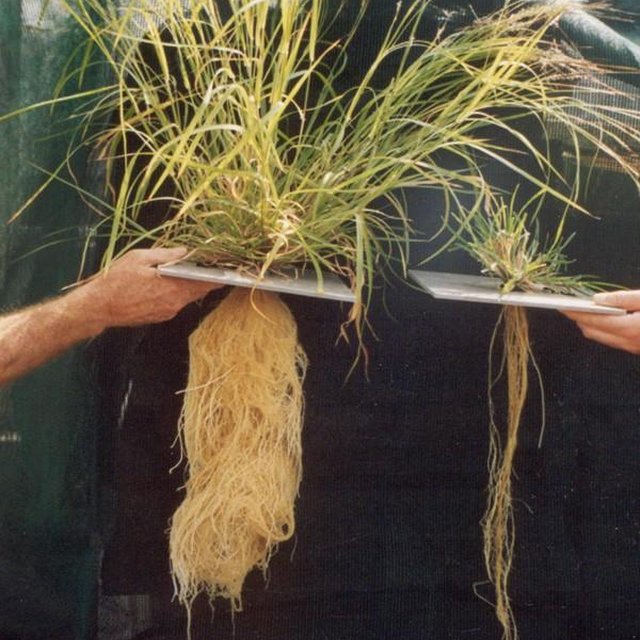
The effect of defoliation on root vigour with lightly clipped spear grass on the left compared with frequently clipped spear grass on the right.
แนวทางการดำเนินการและบรรยากาศการพัฒนาที่เอื้ออํานวย
เป้าหมายหรือวัตถุประสงค์หลักของแนวทาง
The Approach focused on SLM only
Development and promotion of Ecograze principles leading to adoption and thereby enhancing pasture productivity, soil condition and improved livelihoods for pastoralists.
The SLM Approach addressed the following problems: (1) Poor rangeland management leading to loss of productive palatable perennial grasses (3 P grasses) resulting in reduced ground cover, soil erosion, profit loss and in some cases irreversible land degradation. (2) Lack of understanding of underlying problems regarding mismatch of animal numbers to forage supply (pressure on grazing land) in a highly variable climate. (3) No clear technical recommendations regarding resting and rotation of rangeland
เงื่อนไขที่เอื้ออำนวยต่อการนำเอาเทคโนโลยีภายใต้แนวทางนี้ไปปฏิบัติใช้
-
กรอบแนวทางในการดำเนินการด้านกฎหมาย (การถือครองที่ดิน สิทธิในการใช้ที่ดินและน้ำ): The existing land ownership, land use rights / water rights helped a little the approach implementation: In general, implementation of Ecograze principles is undertaken by an individual on private leasehold land. Ecograze is well suited to this individualised system.
เงื่อนไขที่เป็นอุปสรรคต่อการนำเอาเทคโนโลยีภายใต้แนวทางนี้ไปปฏิบัติใช้
-
บรรทัดฐานและค่านิยมทางสังคม วัฒนธรรม ศาสนา: Many pastoralists are conservative and change their systems only slowly.
Treatment through the SLM Approach: There are ongoing education programmes and demonstrations on target properties.
-
การมีไว้ให้หรือการเข้าถึงแหล่งการเงินและบริการ: Investment costs for fencing and water points can be burden on individual land holders.
Treatment through the SLM Approach: There are various possible subsidies available (see 'Inputs', under 'Incentives').
การมีส่วนร่วมและบทบาทของผู้มีส่วนได้เสีย
ผู้มีส่วนได้เสียที่เกี่ยวข้องในแนวทางนี้และบทบาท
| ผู้มีส่วนได้เสียหรือองค์กรที่นำไปปฏิบัติใช้มีส่วนเกี่ยวข้องกับแนวทางนี้อย่างไร |
ระบุผู้มีส่วนได้ส่วนเสีย |
อธิบายบทบาทของผู้มีส่วนได้ส่วนเสีย |
| ผู้ใช้ที่ดินระดับท้องถิ่นหรือชุมชนระดับท้องถิ่น |
|
Traditionally, men undertake on-farm planning, implementation of activities and provide labour. Women play an important role in planning and management of finances, and tend to take a more strategic view on NRM issues than the men. |
| รัฐบาลแห่งชาติ (ผู้วางแผน ผู้ทำการตัดสินใจ) |
|
|
| Govt. agencies/extensionistes |
|
|
การเกี่ยวข้องของผู้ใช้ที่ดินระดับท้องถิ่นหรือชุมชนระดับท้องถิ่นในช่วงต่าง ๆ ของแนวทาง
ไม่มี
ไม่ลงมือ
จ่ายเงินหรือสนับสนุนจากภายนอก
ปฏิสัมพันธ์
ระดมกำลังด้วยตนเอง
การริเริ่มหรือการจูงใจ
workshops/seminars, field days
การวางแผน
consultation with specialists
การติดตามตรวจสอบหรือการประเมินผล
field observations; field observations of pasture composition; economic assessments
Research
on-farm; on-farm field trials and demonstration areas
แผนผัง
Programme organization: Components and activities at different levels of the Ecograze programme.
การตัดสินใจในการเลือกใช้เทคโนโลยี SLM
การตัดสินใจถูกทำโดย
-
ผู้ใช้ที่ดินเพียงผู้เดียว ( ริเริ่มด้วยตัวเอง)
-
ผู้ใช้ที่ดินเป็นผู้ตัดสินใจหลัก โดยการสนับสนุนจากผู้เชี่ยวชาญ SLM
-
ผู้ลงมือปฏิบัติที่เกี่ยวข้องทั้งหมดในฐานะที่เป็นส่วนรวมของแนวทาง
-
ผู้เชี่ยวชาญ SLM เป็นผู้ตัดสินใจหลัก ที่ติดตามให้คำปรึกษากับผู้ใช้ที่ดิน
-
ผู้เชี่ยวชาญ SLM เพียงผู้เดียว
-
นักการเมืองหรือผู้นำ
การตัดสินใจถูกตัดสินอยู่บนพื้นฐานของ
-
การประเมินความรู้ SLM ที่ได้ทำการบันทึกไว้เป็นอย่างดี (การใช้ข้อมูลในการตัดสินใจ)
-
สิ่งที่ค้นพบจากงานวิจัย
-
ประสบการณ์และความคิดเห็นส่วนตัว (ไม่ได้ลงบันทึกไว้)
การสนับสนุนด้านเทคนิค การสร้างขีดความสามารถ และการจัดการด้านความรู้
กิจกรรมหรือการบริการต่อจากนี้เป็นส่วนหนึ่งของแนวทาง
-
การสร้างขีดความสามารถ / การอบรม
-
การบริการให้คำแนะนำ
-
การเสริมความแข็งแกร่งให้กับสถาบัน (การพัฒนาองค์กร)
-
การติดตามตรวจสอบและประเมินผล
-
การวิจัย
การสร้างสมรรถภาพหรือการอบรม
การจัดอบรมถูกจัดขึ้นสำหรับผู้มีส่วนได้ส่วนเสียต่อไปนี้
-
ผู้ใช้ที่ดิน
-
เจ้าหน้าที่ภาคสนาม / ที่ปรึกษา
รูปแบบของการอบรม
-
กำลังดำเนินการ
-
เกษตรกรกับเกษตรกร
-
ใช้พื้นที่ทำการสาธิต
-
จัดการประชุมสู่สาธารณชน
-
จัดคอร์ส
หัวข้อที่อบรม
The Ecograze principles and findings have been incorporated into a training course entitled 'Grazing Land Management (GLM) Education Package'. To date (2005) over 100 farmers have participated in the course and it is anticipated that in the next three years this number will reach over 1,000 producers.
การบริการให้คำแนะนำ
การให้คำแนะนำถูกจัดขึ้น
-
ไปเยี่ยมชมสถานที่
-
ที่ศูนย์ถาวร
Key elements: In on-going research trials in cooperation with land-users, government officers build up their knowledge and capacity to support farmers . Field days form part of the extension and education process. , Government assistance with extension and training through free advice provided by extension officers is helpful, Subsidies to attend training courses like GLM Education also assist with the uptake and adoption of Ecograze. ; There is also a significant interaction between neighbouring properties in sharing of ideas and successes and failures. Commonly, these neighbouring properties are linked through catchment or a Landcare groups.
การสร้างความแข็งแกร่งให้กับองค์กร
องค์กรถูกทำให้แข็งแกร่งขึ้นหรือจัดตั้งขึ้น
-
ไม่
-
ใช่ เล็กน้อย
-
ใช่ ปานกลาง
-
ใช่ อย่างมาก
อธิบายถึงสถาบัน บทบาทและความรับผิดชอบ สมาชิก เป็นต้น
ประเภทของการให้ความช่วยเหลือสนับสนุน
-
ด้านการเงิน
-
การสร้างขีดความสามารถ / การอบรม
-
อุปกรณ์
รายละเอียดเพิ่มเติม
financial (see Annex A3)
การติดตามตรวจสอบและประเมินผล
Bio-physical aspects were regular monitored by 0 through measurements
Socio-cultural aspects were ad hoc monitored by land users through observations
Economic / production aspects were regular monitored by 0 through measurements;
Area treated aspects were ad hoc monitored by 0 through measurements
No. of land users involved aspects were ad hoc monitored by project staff through measurements
There were no changes in the Approach as a result of monitoring and evaluation: Further research and testing, on-going monitoring and evaluation is underway after the initial project. It is too early to state what changes are likely other than obviously needing to adapt to individual land-users resources and available finances.
การวิจัย
การวิจัยกระทำกับหัวข้อต่อไปนี้
-
สังคมวิทยา
-
เศรษฐศาสตร์หรือการตลาด
-
นิเวศวิทยา
-
เทคโนโลยี
The impact of the ongoing research on understanding and implementing the technology through the Ecograze project is significant, and continues to be so. Research into various technical aspects of grazing management has been recently supplemented by economic analyses of costs and benefits.
การสนับสนุนด้านการเงินและวัสดุอุปกรณ์
งบประมาณประจำปีสำหรับองค์ประกอบ SLM เป็นจำนวนดอลลาร์สหรัฐ
-
< 2,000
-
2,000-10,000
-
10,000-100,000
-
10,000-100,000
-
> 1,000,000
Precise annual budget: n.a.
Approach costs were met by the following donors: government (national government): 40.0%; local community / land user(s) (community / local): 60.0%
การบริการหรือแรงจูงใจต่อจากนี้ได้ถูกจัดให้สำหรับผู้ใช้ที่ดิน
-
การสนับสนุนด้านการเงิน / วัสดุอุปกรณ์ให้แก่ผู้ใช้ที่ดิน
-
เงินสนับสนุนสำหรับปัจจัยการผลิต
-
เครดิต
-
แรงจูงใจหรือเครื่องมืออื่น ๆ
การสนับสนุนด้านการเงินและวัสดุอุปกรณ์ให้แก่ผู้ใช้ที่ดิน
Local Landcare groups often request assistance, and this is provided either from the research agencies or from extension officers or through grant applications to the Natural Heritage Trust.
เเรงจูงใจหรือเครื่องมืออื่นๆ
During the research phase of Ecograze, incentives were not available. However, since then, newly established Government initiatives such as the Natural Heritage Trust and the National Action Plan for Salinity and Water Quality, which commenced in 2003, have increased the number of incentives (eg support for on-ground works such as fencing, relocation of water points etc) available to implement management practices such as those recommended in Ecograze.
ผลกระทบและสรุปคำบอกกล่าว
ผลกระทบของแนวทาง
ไม่ใช่
ใช่ เล็กน้อย
ใช่ ปานกลาง
ใช่ อย่างมาก
ช่วยให้ผู้ใช้ที่ดินนำเอาเทคโนโลยี SLMไปใช้และบำรุงรักษาสภาพไว้ได้หรือไม่
Ecograze leads to retention of 3P grasses ('perennial, productive and palatable' grasses), and therefore better pasture coverage, soil retention and greater water use efficiency.
Did other land users / projects adopt the Approach?
Ecograze principles have been included in the new Grazing Land Management Education package - which is being used across northern Australia by Meat and Livestock Australia and other agencies also. It has also now been incorporated into university courses on grazing management.
แรงจูงใจหลักของผู้ใช้ที่ดินเพื่อที่จะนำ SLM ไปปฏิบัติใช้
ความยั่งยืนของกิจกรรมของแนวทาง
ผู้ใช้ปที่ดินสามารถทำให้สิ่งต่างๆ ที่ได้ปฏิบัติใช้โดยแนวทางนี้ยั่งยืนได้หรือไม่ (โดยไม่มีการสนับสนุนจากภายนอก)?
Progress is continuing with further field trials and participation from land users. Those land users who have begun with the Ecograze system can continue without external support.
บทสรุปหรือบทเรียนที่ได้รับ
จุดแข็ง: มุมมองของผู้ใช้ที่ดิน
จุดแข็ง: ทัศนคติของผู้รวบรวมหรือวิทยากรคนอื่นๆ
-
Adoption of the technology should result in financial reward. (How to sustain/ enhance this strength: Continue ongoing economic analysis as an indication of technology success.)
-
The system has been very well documented and adapted to the land users conditions through the involvement of research, the land users, primary industry, and extension. (How to sustain/ enhance this strength: Continued support for applied/on-farm research to adapt the system to the needs of the land users and the environment. Support for long-term monitoring.)
-
State government extension agencies have also readily accepted Ecograze and are actively promoting its principles with landholders.
-
The approach is focussed on changing attitudes to management in the long term. (How to sustain/ enhance this strength: Continue with training and education programmes.)
จุดด้อย/ข้อเสีย/ความเสี่ยง: มุมมองของผู้ใช้ที่ดินแก้ไขปัญหาได้อย่างไร
จุดด้อย/ข้อเสีย/ความเสี่ยง: ทัศนคติของผู้รวบรวมหรือวิทยากรคนอื่นๆแก้ไขปัญหาได้อย่างไร
-
One-off training programs such as the Grazing Land Management Education package (a 3-day course) may not be enough to sustain initial commitment to testing new management options.
Create support network and supply follow-up training and/or support.
การอ้างอิง
ผู้ตรวจสอบ
-
David Streiff
-
Deborah Niggli
วันที่จัดทำเอกสาร: 18 ธันวาคม 2008
การอัพเดทล่าสุด: 4 เมษายน 2018
วิทยากร
-
Andrew Ash (andrew.ash@csiro.au) - ผู้ใช้ที่ดิน
คำอธิบายฉบับเต็มในฐานข้อมูล WOCAT
การจัดทำเอกสารถูกทำโดย
องค์กร
- CSIRO (CSIRO) - ออสเตรเลีย
โครงการ
- Book project: where the land is greener - Case Studies and Analysis of Soil and Water Conservation Initiatives Worldwide (where the land is greener)
การอ้งอิงหลัก
-
Ash A, Corfield J and Taoufik T (undated) The ECOGRAZE Project: developing guidelines to better manage grazing country. CSIRO, Meat and Livestock Commission and Queensland Government:
